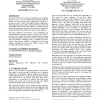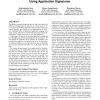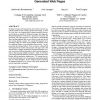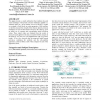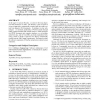WWW
2004
ACM
15 years 8 days ago
2004
ACM
The ability of the Web to share data regardless of geographical location raises a new issue called remote authoring. With the Internet and Web browsers being independent of hardwa...
WWW
2004
ACM
15 years 8 days ago
2004
ACM
The ability to accurately identify the network traffic associated with different P2P applications is important to a broad range of network operations including application-specifi...
WWW
2004
ACM
15 years 8 days ago
2004
ACM
Dividing web pages into fragments has been shown to provide significant benefits for both content generation and caching. In order for a web site to use fragment-based content gen...
WWW
2004
ACM
15 years 8 days ago
2004
ACM
This paper presents a search architecture that combines classical search techniques with spread activation techniques applied to a semantic model of a given domain. Given an ontol...
WWW
2004
ACM
15 years 8 days ago
2004
ACM
In this paper we present HearSay, a system for browsing hypertext Web documents via audio. The HearSay system is based on our novel approach to automatically creating audio browsa...
WWW
2004
ACM
15 years 8 days ago
2004
ACM
We present a question answering (QA) system which learns how to detect and rank answer passages by analyzing questions and their answers (QA pairs) provided as training data. We b...
WWW
2004
ACM
15 years 8 days ago
2004
ACM
Web accessibility is an important goal. However, most approaches to its attainment are based on unrealistic economic models in which Web content developers spend too much and rece...
WWW
2004
ACM
15 years 8 days ago
2004
ACM
Two important architectural choices underlie the success of the Web: numerous, independently operated servers speak a common protocol, and a single type of client--the Web browser...
WWW
2004
ACM
15 years 8 days ago
2004
ACM
We present a Semantic Web application that we call CS AKTive Space1 . The application exploits a wide range of semantically heterogeneous and distributed content relating to Compu...
WWW
2004
ACM
15 years 8 days ago
2004
ACM
The ability to determine what day-to-day activity (such as cooking pasta, taking a pill, or watching a video) a person is performing is of interest in many application domains. A ...
